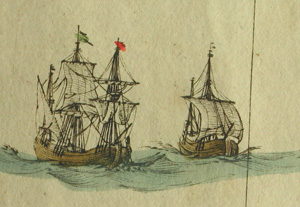 Whalers boiling the whale blubber, heavy smoke covering the area. The painting shows clearly what a double blubber oven looked like. (Image: Watercolour painting by Fotherby, 1613.)
Whalers boiling the whale blubber, heavy smoke covering the area. The painting shows clearly what a double blubber oven looked like. (Image: Watercolour painting by Fotherby, 1613.)
 Sailing towards Spitsbergen. Excerpt from an 18th century map.
Sailing towards Spitsbergen. Excerpt from an 18th century map.
 Fotherby’s depiction of whaling in 1613. Small boats facing huge whales – a very risky business! (Image: Watercolour painting by Fotherby, 1613.)
Fotherby’s depiction of whaling in 1613. Small boats facing huge whales – a very risky business! (Image: Watercolour painting by Fotherby, 1613.)
At the beginning of June, the ships arrive in the fjord. The goal of the long journey from home in Europe has been reached. There is little ice in the fjord this year, so it does not take long for the ships to anchor in the fjord off the whaling station. While commands are being shouted, and other noise is buzzing, the small boats – the sloops – are being lowered into the water. Equipment is loaded onto them and rowed ashore. Each member of the crew has his own tasks to perform, and before long they have started repairing the damage the winter has done. Everyone is busy. Copper vessels, used for rendering oil from the whale blubber, are placed on the blubber ovens. People keep a look-out to spot whales on their way into the fjord. Everyone is preparing for the whaling, which is about to start.
Until the middle of the 17th century, whaling in Svalbard happened near the coast and in the fjords, and only in the summer. This was because the whaling stations were situated ashore, where the whale blubber was boiled to make whale oil in large vessels.
In the beginning, the shore stations were only temporary, with simple and provisional blubber ovens on the beach. The work was carried out under the stars and the crew lived in simple shelters. Eventually solid residences, storage spaces, workshops and brick tryworks for rendering oil were built in places where whaling was consistently good, and these were used again and again for many years.
The ships that travelled northwards each year each carried between four and six small boats which were used for the actual whaling. Each small boat had a crew of six men. The harpooner sat in the front of the boat, and the cox sat in the back. Between the two there were four rowers. When the whale was discovered it was important to get as close to it as possible so as to get a perfect shot with the harpoon, which had long cords attached to it. The cords were pulled out when the whale dived suddenly after being hit. Friedrich Martens (1671) described this as “the whale running like the wind with the boat on tow, so that our ears are whistling”. It was essential that the cords were not restricted, because if they got stuck the small boat could easily be pulled under water. Equally, if the boat was not facing the same direction as the whale was travelling, it could capsize. Survival in the ice-cold water was unlikely.
Several small boats took part in each hunt, harpooning the whale in turn each time it returned to the surface to breathe. In the end the whale was exhausted from loss of blood and the weight of all the boats. The whalers could then approach the whale, which was finally dispatched with lances. It was then towed ashore or to the side of the ship, where flensing knives were used to remove long rashers of blubber from the whale’s body. Once ashore, the rashers were cut into small pieces on benches specially designed for the purpose. The pieces were boiled in copper vessels on the blubber ovens and rendered into oil. The oil was cooled down and purified using large coolers filled with water. Barrels of finished oil were stored on the ship until tend of the season, when the ship returned home.
In the middle of the 1600s a long cold snap covered the fjords ice for lengthy periods, even during the summer. Bowhead whales disappeared from of the fjords, moving to the open sea by the edge of the drift ice. Whaling could no longer happen from the shore, and gradually the whaling stations were abandoned. A new whaling period began, one based on whaling in the sea and on the ice.
In August, the whalers packed all their equipment and tools, set sail and journeyed homewards, as they had done at the end of the season for many years. The whaling station was left in the hands of the winter storms, like so many years before. The following year the whalers did not return, and the station was left to itself ever since. The oil cookeries and the houses decayed and eventually became ruins, remains of busy work over so many years of short, but active summer months. Nature reclaims the land, and the traces of the people who caught whales and rendered oil from the blubber are fading and are becoming more difficult to see. But if you put your ear to the wind and listen, you may be able to hear the faint sounds of hammers against copper vessels, banging from the coopers’ workshop, squeaking from the ropes that tied the ships to the harbour, and the distant voices and laughter of the workers, bent over the blubber ovens when the oil was boiling. You may also hear the faint sound of a cry alerting everyone that a whale is on its way into the fjord.